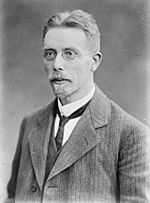August Krogh facts for kids
Quick facts for kids
August Krogh
|
|
|---|---|

August Krogh
|
|
| Born | 15 November 1874 Grenå
|
| Died | 13 September 1949 (aged 74) Copenhagen
|
| Nationality | Danish |
| Known for | Krogh's principle |
| Awards | Nobel Prize in Physiology or Medicine |
| Scientific career | |
| Fields | Zoophysiology |
| Institutions | University of Copenhagen |
| Influences | Christian Bohr, A. Bornstein |
| Influenced | Joseph Barcroft, Torkel Weis-Fogh, Hans Ussing |
Schack August Steenberg Krogh ForMemRS (born November 15, 1874 – died September 13, 1949) was a Danish professor. He taught at the University of Copenhagen from 1916 to 1945, focusing on how animals' bodies work (called zoophysiology). He made many important discoveries in how living things function. He is also famous for creating the Krogh Principle.
In 1920, August Krogh won the Nobel Prize in Physiology or Medicine. He received this award for finding out how tiny blood vessels, called capillaries, are controlled in our muscles. Krogh was the first to explain how blood flow in muscles and other organs changes to meet their needs. This happens by opening and closing even smaller vessels called arterioles and capillaries.
Besides his science work, Krogh also helped start the well-known company, Novo Nordisk.
Contents
The Early Life of August Krogh
August Krogh was born in Grenaa, a town in Denmark. His father, Viggo Krogh, was a shipbuilder. August went to school at the Aarhus Katedralskole in Aarhus. He then studied at the University of Copenhagen. He earned his master's degree in 1899 and his PhD in 1903.
Krogh's Amazing Discoveries
Krogh was a pioneer in studying how different animals' bodies work. He wrote his PhD paper on how frogs breathe through their skin and lungs. This work was called Respiratory Exchange of Animals (1915).
Later, Krogh studied how aquatic animals control their water and salt levels. He published books like Osmotic Regulation (1939) and Comparative Physiology of Respiratory Mechanisms (1941). He also wrote over 200 research papers for science journals.
Inventing Scientific Tools
August Krogh was also good at building scientific instruments. Some of his inventions became very useful. These included the spirometer, which measures how much air you can breathe. He also made a device to measure basal metabolic rate, which is how much energy your body uses at rest.
Becoming a Professor
Krogh started teaching at the University of Copenhagen in 1908. In 1916, he became a full professor. He then led the university's first laboratory for animal physiology (zoophysiology).
Bringing Insulin to Denmark
Krogh and his wife, Marie, played a big part in bringing insulin to Denmark. This happened soon after insulin was discovered in 1922 by Frederick Banting and Charles Best. Marie Krogh was a doctor who treated patients with type 1 diabetes. She also had type 2 diabetes herself, so she was very interested in this new medicine.
Together with another doctor, Hans Christian Hagedorn, August and Marie Krogh started the Nordisk Insulinlaboratorium. Here, Krogh helped set up a way to produce insulin in Denmark. They extracted the hormone from the pancreatic glands of pigs using ethanol. This was a huge step for treating diabetes in Denmark.
Working with Other Nobel Winners
In the 1930s, Krogh worked with two other scientists who also won Nobel Prizes. These were George de Hevesy, a radiochemist, and Niels Bohr, a physicist. They studied how membranes (like cell walls) allow water and radioactive isotopes to pass through. Together, they helped Denmark get its first cyclotron. This machine was used for experiments on animals, plants, and in dental and medical work.
Krogh's Family
In 1905, August Krogh married Marie Krogh (born Jørgensen, 1874–1943). Marie was also a well-known scientist. Much of August Krogh's research was done closely with her.
August and Marie had four children. Their youngest daughter, Bodil, was born in 1918. She also became a physiologist, just like her parents. In 1975, she became the first woman president of the American Physiological Society. Bodil married another famous physiologist, Knut Schmidt-Nielsen.
Krogh's Lasting Impact
August Krogh had many students who became important scientists. One of them was Torkel Weis-Fogh, who was a pioneer in studying how insects fly. Krogh and Weis-Fogh wrote an important paper together about insect flight in 1951.
Krogh's name is remembered in two important scientific ideas:
- Krogh length: This is the distance that nutrients travel from tiny blood vessels (capillaries) to cells. It helps scientists understand how nutrients reach different parts of the body.
- Krogh's principle: This idea says that for many science problems, there is a "best animal" to study. It means that if you want to understand a certain body function, you should pick the animal where that function is easiest to study.
See also
 In Spanish: August Krogh para niños
In Spanish: August Krogh para niños

